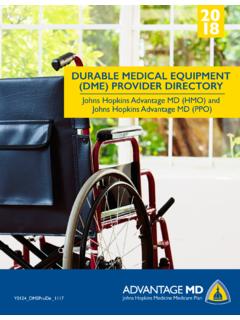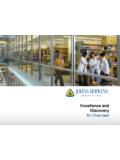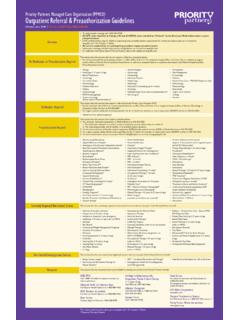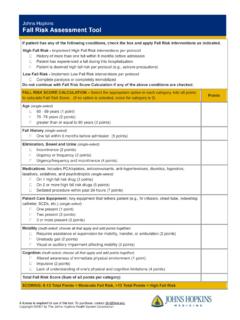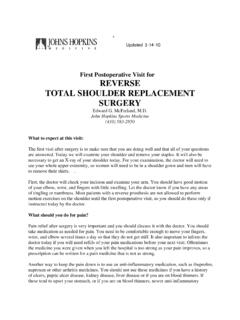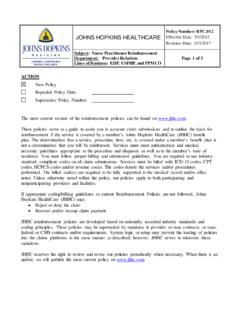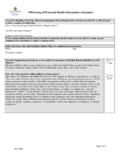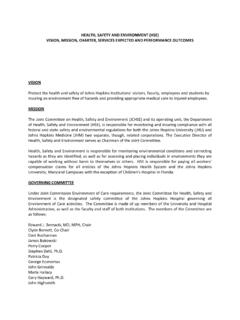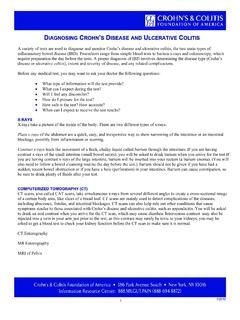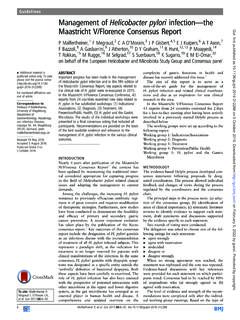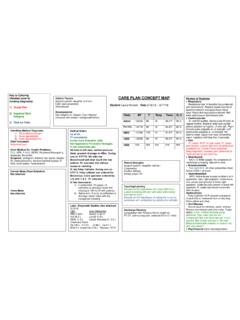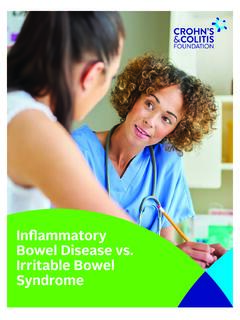Transcription of Collagenous & Lymphocytic Colitis: Introduction
1 Location of the colon in the & Lymphocytic colitis : Introduction Researchers (Read, et al.) used the term microscopic colitis in 1980 to describe the entity of chronic, watery diarrhea in patientswith only microscopic evidence of inflammation. The term is currently used to include Collagenous and Lymphocytic colitis . What are Collagenous and Lymphocytic colitis ? Collagenous and Lymphocytic colitis are clinical and pathologic syndromes representing forms of microscopic colitis that affect the large intestine. Both disordersusually present in middle-aged patients in the fifth or sixth decade of life. Collagenous colitis primarily affects women. The predominance in the female to malepopulation is 8:2. Lymphocytic colitis is found in both men and women with an equal male-to-female gender distribution. Those affected by Lymphocytic colitis areslightly younger; the mean age of onset is 53 years.
2 In both disorders, most patients present with complaints of chronic, watery, noninfectious diarrhea, and abdominalpain. Clinical and histology differences do exist between Lymphocytic colitis and Collagenous colitis . These disorders rarely affect first described Collagenous colitis in 1976 as having a distinctive colorectal histopathology that included a subepithelial collagen band beneath the epitheliumsurface in colorectal mucosa. This disorder has two main histological components: 1) increased collagen deposition and 2) colitis . It is a chronic inflammatory processof unknown etiology and a relatively new entity in the realm of inflammatory bowel diseases. The incidence of this disorder is approximately cases per 100,000population. In the presence of chronic diarrhea, the frequency of Collagenous colitis ranges from 1. Figure 2. A. Histology of normal colon; B, Collagenous colitis ; C, Lymphocytic histopathology of Lymphocytic colitis is similar to that of Collagenous colitis except there is no Collagenous thickening.
3 Because of the clinical and histologicalsimilarities of these two disorders, they are commonly considered as a single category of inflammatory bowel disease for the purpose of treatment. SymptomsThe main symptom in Collagenous colitis , as well as Lymphocytic colitis , is chronic, watery diarrhea. Sixty percent of these patients are unable to pinpoint the exactonset of their symptoms, although some relate preceding gastroenteritis. Patients describe 5 10 watery bowel movements per day persisting for an average of fiveyears, but as long as 20 years. Diarrhea is usually accompanied by cramps and diffuse abdominal pain, which rarely occurs at night. These patients are frequentlymisdiagnosed as having irritable bowel arthritis may be a manifestation of Collagenous colitis and is seen in approximately 7% of cases. This form of arthritis, seronegative for rheumatoid factor,is nondestructive and may involve one or several joints.
4 Treatment of the underlying colitis aids in the resolution of these symptoms. Seventeen to 40% of patientswith Collagenous colitis present with a variety of other immune-related disorders, including Sj gren s syndrome, giant cell arteritis, recurrent iritis, celiac disease,rheumatoid arthritis, thyroiditis, and myasthenia gravis. Copyright 2001-2013 | All Rights North Wolfe Street, Baltimore, Maryland 21287 Collagenous & Lymphocytic colitis : Anatomy The colon may be divided into the cecum, the ascending colon, the transverse colon, the descending colon, the sigmoid colon and the rectum. The large intestine(colorectum) begins at the cecum, a pouch approximately 2 3 inches long. Ileal contents empty into the cecum through the ileocecal valve. The appendix extendsfrom the base of the cecum. The ascending colon rises from the cecum along the right posterior wall of the abdomen to the undersurface of the liver.
5 At this point itturns toward the midline (hepatic flexure), becoming the transverse colon. The transverse portion crosses the abdominal cavity toward the spleen and turns downwardat the splenic flexure. Continuing along the left side of the abdominal wall to the rim of the pelvis, the descending colon turns medially and inferiorly to form theS-shaped sigmoid colon. The rectum extends from the sigmoid colon to the pelvic floor muscles where it continues as the anal canal, terminating at the anus (Figure3). Figure 3. Normal large intestine is approximately 7 8 feet long and 2 1/2 inches in diameter. It is the site of water absorption. Glands secrete large quantities of alkaline mucus thatlubricate the intestinal contents and neutralize acids formed by bacteria in the intestine. These bacteria aid in decomposition of undigested food residue, unabsorbedamino acids, cell debris, and dead bacteria through the process of putrefaction.
6 Maintenance of potassium balance is also assigned to the colon, where the epitheliumabsorbs and secretes potassium and bicarbonate. Copyright 2001-2013 | All Rights North Wolfe Street, Baltimore, Maryland 21287 Collagenous & Lymphocytic colitis : Causes Overview The cause of Collagenous and Lymphocytic colitis is unknown. No definitive causative agent has been identified, although an association with ingestion of nonsteroidalantiinflammatory (NSAIDs) has been suggested. This link requires further investigation. Pathogenesis Hypotheses concerning the pathogenesis of this disorder have included immune dysregulation leading to inflammation of the colon, collagen synthesis abnormalities,bacterial agents or toxins, mast cell abnormalities, and plasmatic vasculosis. It has also been suggested that a foreign luminal agent, perhaps a bacterial organism,may initiate colorectal mucosal inflammation.
7 This may lead to an immunological cross-reactivity with an endogenous antigen produced by surface enterocytes(Figure 4). Figure 4. Mechanism of injury in Collagenous pathogenesis of chronic diarrhea in Lymphocytic and Collagenous colitis is multifactorial. Diarrhea may result from net fluid secretion in the colon from decreasedabsorption due to epithelial surface damage and deposition of collagen along with a normal rate of fluid secretion into the lumen from intact crypts. Small-boweldysfunction has been noted in some patients, in addition to bile salt wasting, fatty acid malabsorption, small-bowel net secretion, and in rare circumstances, villousatrophy. Diarrhea may be exacerbated by these additional abnormalities (Figure 5). The physician must consider thyroid disease as a possible element in thediarrheal diathesis. Figure 5. Pathogenesis of diarrhea in Collagenous and Lymphocytic colitis ; A, normal epithelium; B,damaged epithelium.
8 Copyright 2001-2013 | All Rights North Wolfe Street, Baltimore, Maryland 21287 Collagenous & Lymphocytic colitis : Diagnosis Laboratory TestsRoutine blood studies are generally normal in these patients, but Westergren sedimentation rate elevation and eosinophil count abnormalities are not uncommon. Inaddition, abnormalities in complement levels and serum immunoglobulins (G [IgG], C3, or C4) may be found. Antineutrophilic cytoplasmic antibodies have been foundin cases of Collagenous colitis . No elevations of procollagen III, cytokines, or serum secretagogues have been reported. In Collagenous and Lymphocytic colitis , stoolspecimens are negative for occult blood, ova, parasites, bacterial pathogens and Clostridium difficile toxin. As many as 55% of Collagenous colitis patients haveleukocytes (white blood cells) on stool smears. These patients may also present with mild steatorrhea, elevated fecal clearance of alpha-antitrypsin, and protein-losing enteropathy.
9 Bile salt breath testing with C-glycocholate is typically abnormal, indicating bile salt deconjugation or should suspect Collagenous and Lymphocytic colitis in middle-aged patients presenting with chronic, watery, noninfectious diarrhea. Often mistaken forirritable bowel syndrome, there are key differences. Collagenous / Lymphocytic colitis patients present at an older age and without long-term history of alternatingconstipation and diarrhea. Radiological DiagnosisGastrointestinal radiographic studies are not diagnostic in Collagenous and Lymphocytic colitis . Usually upper and lower gastrointestinal barium studies are normal, butcolonic mucosal irregularities and adenomatous polyps are occasionally noted. Endoscopic DiagnosisLower endoscopy with colonic biopsy is the standard of diagnosis. Colonoscopy is the primary method for examination of the colon with extremely low complicationrates ( ).
10 The procedure allows the physician to visualize and biopsy the lower gastrointestinal tract with a high-resolution color view of the mucosa throughwide-angle optics. The endoscope or colonoscope has a flexible shaft to accommodate colonic bends and air insufflation capabilities are incorporated with waterwash to improve visibility. Colonoscopes have a full range of endoscopic accessories including biopsy forceps, electrocoagulating hot biopsy forceps, cytologybrushes, washing and spraying catheters, sclerotherapy needles, a wide range of dilatory balloons and bougies, as well as snares for polypectomy and retrievaldevices (Figure 6). Colonoscopy permits visualization of the anus, rectum, sigmoid, descending, transverse, and ascending colon, and the terminal ileum. Figure 6. Position of the endoscope in the colon for for this procedure requires that the patient have nothing by mouth for eight hours (except for essential medications) prior to the procedure.
